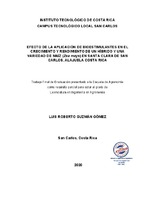Mostrar el registro sencillo del ítem
Efecto de la aplicación de bioestimulantes en el crecimiento y rendimiento de un híbrido y una variedad de maíz (Zea mays) en Santa Clara de San Carlos, Alajuela Costa Rica
| dc.contributor.advisor | Echeverría-Beirute, Fabián | es |
| dc.contributor.author | Guzmán-Gómez, Luis Roberto | |
| dc.date.accessioned | 2021-01-20T19:12:01Z | |
| dc.date.available | 2021-01-20T19:12:01Z | |
| dc.date.issued | 2020 | |
| dc.identifier.uri | https://hdl.handle.net/2238/12296 | |
| dc.description | Proyecto de Graduación (Licenciatura en Ingeniería en Agronomía) Escuela de Ingeniería en Agronomía, Instituto Tecnológico de Costa Rica, 2020 | es |
| dc.description.abstract | El cultivo de maíz (Zea mays L.) es de gran importancia a nivel mundial debido a sus diversas formas de utilización. Sin embargo, en Costa Rica este cultivo ha sido poco desarrollado, debido a un débil grado de tecnificación, alta inversión y rendimientos bajos. Los bioestimulantes son productos biológicos con capacidad de potenciar la fisiología de los cultivos, influyendo en sus procesos metabólicos con una mejora en su desarrollo y por ende en el rendimiento productivo. Con el objetivo de evaluar el efecto de tres bioestimulantes en el crecimiento y rendimiento de dos variedades de maíz: un híbrido de maíz blanco (HR-245) y una variedad de maíz amarillo (EJN-2). Se realizó la presente investigación en la finca La Esmeralda del Tecnológico de Costa Rica, Campus Tecnológico Local San Carlos. Se utilizó un modelo estadístico de bloque generalizado donde se evaluaron 5 tratamientos con 6 repeticiones correspondientes a 3 productos bioestimulantes (Alga 18, Tricho-Eco y Gamba Bio) más la combinación de dos productos (Alga 18+Tricho-Eco) y un testigo. Las variables evaluadas fueron altura de la planta, peso seco de raíz y planta, grosor de tallo, características de la mazorca (longitud, peso, grosor y número de hileras), peso de granos totales, peso de 100 granos y rendimiento, además de un análisis económico para evaluar su rentabilidad. En forma general, se encontraron diferencias significativas en todas las variables del estudio a excepción de la altura de la planta, siendo los tratamientos Alga 18 y Alga 18+Tricho-Eco quienes mostraron mayor influencia en el peso seco de raíz y planta en etapas iniciales, así como en el grosor de tallo. De la misma forma, las características de la mazorca y peso de granos también se vieron incrementadas, obteniendo un aumento en los rendimientos que oscilan entre los 0,52 y 1,74 ton/ha (p-valor<0,0001) con respecto al testigo. En el análisis económico, se demostró que la aplicación de bioestimulantes logró incrementar las ganancias económicas (con la excepción de Tricho-Eco en el maíz amarillo) y que la aplicación de Alga 18 en ambas variedades obtuvo los valores más elevados al reportar un incremento entre los 574 910 y 610 665 mil colones por hectárea. | es |
| dc.description.abstract | Maize (Zea mays L.) is of great importance worldwide due to its various forms of use. However, in Costa Rica this crop has been underdeveloped, due to a weak degree of technification, high investment and low yields. Biostimulants are biological products that modify crop´s physiology, influencing their metabolic processes with an improvement in their development and therefore in productive performance. With the objective of evaluating the effect of three biostimulants on the growth and yield of two varieties of corn: a hybrid of white corn (HR-245) and a variety of yellow corn (EJN-2). The present investigation was carried out at the La Esmeralda farm of the Costa Rica Technological Campus San Carlos Local Technology. A generalized block statistical model was used where 5 treatments with 6 repetitions corresponding to 3 biostimulant products (Alga 18, Tricho-Eco and Gamba Bio) plus the combination of two products (Alga 18 + Tricho-Eco) and a control were evaluated. The variables evaluated were plant height, root dry weight and plant, stem thickness, characteristics of the cob (length, weight, thickness and number of rows), weight of total grain weight of 100 grains and performance, and an economic analysis to evaluate its profitability. In general, significant differences were found in all study variables except for plant height, with the Alga 18 and Alga 18 + Tricho-Eco treatments being the ones that showed the greatest influence on the dry weight of roots and plants in the initial stages, as well as the stem thickness. In the same way, the characteristics of the ear and grain weight were also increased, obtaining an increase in yields that oscillate between 0.52 and 1.74 ton / ha (p-value <0.0001) with respect to to the witness. In the economic analysis, it was shown that the application of biostimulants managed to increase the economic gains (with the exception of Tricho-Eco in yellow corn) and that the application of Alga 18 in both varieties obtained the highest values by reporting an increase between the 574 910 and 610 665 thousand colones per hectare. | es |
| dc.language.iso | spa | es |
| dc.publisher | Instituto Tecnológico de Costa Rica | es |
| dc.rights | acceso abierto | es |
| dc.subject | Research Subject Categories::FORESTRY, AGRICULTURAL SCIENCES and LANDSCAPE PLANNING::Plant production::Agronomy | es |
| dc.subject | Fisiología vegetal | es |
| dc.subject | Productos agrícolas | es |
| dc.subject | Rendimiento | es |
| dc.subject | Variedades | es |
| dc.subject | Cultivo de maíz | es |
| dc.subject | Plant physiology | es |
| dc.subject | Agricultural products | es |
| dc.subject | Performance | es |
| dc.subject | Varieties | es |
| dc.subject | Corn crop | es |
| dc.title | Efecto de la aplicación de bioestimulantes en el crecimiento y rendimiento de un híbrido y una variedad de maíz (Zea mays) en Santa Clara de San Carlos, Alajuela Costa Rica | es |
| dc.type | proyecto fin de carrera | es |


